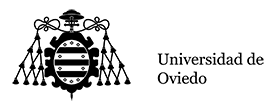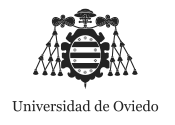Estudia
- Artes y humanidades
-
Ciencias
- Máster Erasmus Mundus en Recursos Biológicos Marinos
- Máster Universitario en Análisis de Datos para la Inteligencia de Negocios
- Máster Universitario en Biotecnología Alimentaria
- Máster Universitario en Biotecnología Aplicada a la Conservación y Gestión Sostenible de Recursos Vegetales
- Máster Universitario en Biotecnología del Medio Ambiente y la Salud
- Máster Universitario en Ciencias Analíticas y Bioanalíticas
- Máster Universitario en Conservación Marina
- Máster Universitario en Física Avanzada: Partículas, Astrofísica, Nanofísica y Materiales Cuánticos
- Máster Universitario en Modelización e Investigación Matemática, Estadística y Computación*
- Máster Universitario en Química Teórica y Modelización Computacional
- Máster Universitario en Química y Desarrollo Sostenible
- Máster Universitario en Recursos Geológicos e Ingeniería Geológica
- Ciencias de la salud
- Ciencias sociales y jurídicas
- Ingeniería y arquitectura
- Información, acceso y becas
Espectrometría de Masas para Análisis Elemental y Molecular
- Clases Expositivas (17.5 Hours)
- Prácticas de Aula/Semina (4 Hours)
- Tutorías Grupales (1 Hours)
This subject belongs to the MODULE 1 (compulsory, theoretical), which has 7 different subjects lasting all of them 3 ECTS. Specifically, this is one out of the 5 subjects of the Master that will be taught in englsih, as part of the final aim of converting the whole master into a full international degree in a short period of time
Mass Spectrometry (MS) has established as an essential tool in any laboratory for both the identification (qualitative analysis) and determination (quantitative analysis) of compounds of interest in biology, clinical and environmental analysis. This subject will provide the student with the basic and applied knowledge required to choose the adequate MS technique to solve any specific problem. In addition some important applications nowadays will be explained in detail.
In the context of this master degree, this subject will serve as an indispensable introduction to many optional subects such as: “Análisis Clínicos y Farmacológicos, Proteómica cualitativa y cuantitativa y análisis de biomarcadores, Análisis de alimentos y toxicológico, Análisis Medioambiental y Métodos de análisis basados en el uso de isótopos estables”. It is also closely related to the other compulsory subject titled “Técnicas actuales en ciencias de separación”.
This is a compulsory subject so its requisites match up with the general ones of the master degree:
“The prerequisite for entry the master will be a first cycle degree in one of the following disciplines:
- Bachelor degree in chemistry
- Bachelor degree in the related disciplines: Physics, Geology, Biology, Biochemsitry, Pharmacy, Medicin, Environmental Sciences and Food technology
- Bachelor degree in engineering chemistry
- Other related Bachelor degrees in Sciences and Life Sciences.
In the case of students from other countries which could have studied different disciplines, every specific case will be evaluated to check if the student profile matches the prerequisites of the master.”
The expected learning outcomes will be:
RA-1.- The student should demonstrate knowledge and understanding of essential facts, concepts, principles and theories relating to the subject areas studied during the Master program.
RA-2.- The student should be able to read and understand scientific papers published in international journals.
RA-3.- The student should be able to write correctly a report about a specific research topic and present it in front of a specialized audience.
RA-4.- The student should be able to apply knowledge in practice, in particular to solve specific and complex problems.
Basic competences:
CB6.- Ability to understand the knowledge required to be original in the development and application of ideas, usually in a research context
CB8.- Ability to integrate knowledge and handle complexity, and formulate judgements with incomplete or limited information, but that include reflecting on ethical responsibilities linked to the application of their knowledge and judgements
CB9.- Ability to communicate their conclusions, and the knowledge and rationale underpinning these, to specialist and non-specialist audiences clearly and unambiguously.
CB10.- Learning skills that will allow them to continue to study in a manner that may be largely self-directed or autonomous, and to take responsibility for their own professional development.
General Competences:
CG1.- Ability to analyse material and synthesise concepts
CG4.- Information-management competences, in relation to primary and secondary information sources and ability to manage adequately such obtained information.
Specific Competences:
CE1.- Knowledge of the basis for the main analysis techniques, both already established and state-of-the-art techniques, and the related experimental methodologies.
CE2.- Skills required for the conduct of advanced laboratory procedures and use of instrumentation in synthetic and analytical work both in a research and routine lab.
CE-5.- Ability to choose the right analytical technique for the analysis and characterization of different materials and nanomaterials.
CE-6.- Ability to choose the right analytical technique for the analysis, characterization and quantification of compounds of interest, both inorganics and organics, in complex samples.
CE-7.- Ability to assimilate and evaluate laboratory results to solve problems efficiently
The contents of the subject will be:
Mass spectrometry. Isotopes. Accurate mass and accuracy. Resolution. Mass calibration.
Ionisation sources: electron ionisation, chemical ionisation, fast atom bombarment, electrospray, MALDI, ICP.
Mass analyzers: quadrupole, time of flight, magnetic sector, ion trap, ICR, orbritrap. Tandem Mass spectrometry
Hybrid systems: interfaces to GC, CE and HPLC
Mass spectra interpretation. Elucidation of chemical structures.
Quantitative analysis using MS. Internal standards. Stable isotopes and isotope dilution.
Applications: peptides and proteins, clinical samples, food analysis, environmental pollutants, pharmaceutical products.
These contents will be organised into the following units and sections:
Unit 1: Instrumentation in MS
Section 1. History of MS. Introduction to MS. Isotopes. Accurate mass and accuracy. Resolution. Mass calibration. Isotopic standards
Section 2. Ionisation proceses. electron ionisation, chemical ionisation, fast atom bombarment, electrospray, MALDI, ICP.
Section 3. Mass Analizers: quadrupole, time of flight, magnetic sector, ion trap, ICR, orbritrap. And other mass analyzers combinations.
Section 4. Ion detection systems and data treatment.
Section 5. Interfaces: chromatography-MS, electrophoresis-MS, Tandem MS/MS.
Section 6. Information for the structural elucidation of organic compounds: precursor ion, fragmentation processes, isotopic distribution.
Section 7. Elemental and organic spectra interpretation.
Section 8. Quantitative analysis using MS: use of stable isotopes and isotope dilution methods.
Unit 2. Applications to Bioanalysis, clinical, pharmaceutical and environmental
Section 9. Structural analysis of peptides and proteins using MS: Intact protein analysis. Peptide mapping. Peptide sequencing. “Top-down” and “bottom-up” strategies
Section 10. Applications of MS for clinical chemistry, food analysis, environmental analysis and determination of pharmaceutical products.
The wide variety of learning and teaching approaches used are divided into 2 big groups:
On-site activities:
- 16 lectures (one hour each), supported by multimedia teaching techniques, where the basis of MS will be introduced to the students.
- 4 problem-solving classes (one hour each) where different topics and problems, previously worked out by the students, will be discussed and solved.
- Teaching in smaller groups (1 hour), where the most involved issues related to MS spectra interpretation will be discussed. Student participation will be promoted
Distance activities:
- Individual work: The student should devote time to assimilate the concepts and background introduced by the teacher during the lectures. In addition, the student should go into the main topics using primary and secondary information sources, including information retrieval through on-line computer searches. Problem-solving classes will be used to clarify questions raised during such work.
- Team work: The teaching in smaller groups will be performed in groups. Such goups will be maintained for any other activity which could take place, for example, in problem-solving clases. Also, ability to interact with other people and to engage in team-working will be promoted.
Student workload (hours) for each specific section is given in the following table:
On-site work | Distance work | |||||||||||
Sections | Hours | Lectures | Problem solving classes | Laboratory practices, | Clinical practices | Small-group teaching | External practices | Evaluation sessions | Total | Team-work | Individual work | Total |
Section 1 | 9 | 3 | 1 | 4 | 2 | 3 | 5 | |||||
Section 2 | 7 | 2 | 2 | - | 5 | 5 | ||||||
Section 3 | 7.5 | 2 | 0.5 | 2.5 | - | 5 | 5 | |||||
Section 4 | 3.5 | 1 | 1 | - | 2.5 | 2.5 | ||||||
Section 5 | 4.5 | 1 | 0.5 | 1.5 | - | 3 | 3 | |||||
Section 6 | 6 | 1 | 1 | - | 5 | 5 | ||||||
Section 7 | 11 | 2 | 1 | 3 | 5 | 3 | 8 | |||||
Section 8 | 9 | 1 | 1 | 2 | 3 | 4 | 7 | |||||
Section 9 | 8 | 1 | 0.5 | 1.5 | 2 | 4.5 | 6.5 | |||||
Section 10 | 9.5 | 2 | 2 | 4 | 1 | 4.5 | 5.5 | |||||
Total | 75 | 16 | 4 | - | - | 1 | - | 1.5 | 22,5 | 13 | 39,5 | 52,5 |
Teaching and learning methods | Hours | % | Total | |
On-site | Lectures | 16 | 21.3 | 22,5 |
Problem-solving classes | 4 | 5.3 | ||
Laboratory practices | - | - | ||
Clinical practices | - | - | ||
Small-group teaching | 1 | 1.3 | ||
External practices | - | - | ||
Evaluation sessions | 1.5 | 2 | ||
Distance | Team work | 13 | 17,3 | 52,5 |
Individual work | 39,5 | 52,7 | ||
Total | 75 | 100 | ||
The procedures, different aspects and the criteria used for the assessment of student performance is given in the following table. The weight of each assessment procedure in the final mark of the student is also given:
Procedure | Assessment criteria | Instrument | Weight (%) |
Written examination | Command of the matter and degree of attainment of the expected learning outcomes. | Exam | 80 % |
Assessment of individual work | Participation and interest shown during the problema-solving and and small-group teaching classes. | Exercises. Personal assessment of the teacher. | 20 % |
General:
- “Mass spectrometry: a text book” J. H. Gross, Ed. Springer-Verlag, Heidelberg, Alemania. 2004.
- “ICP Mass Spectrometry Handbook”, S. Nelsm, Ed. Blackwell Publishing, CRC Press, USA, 2005.
- “Bioanalytical Chemistry” A. Manz, N. Pamme, D. Iossifidis, Imperial College Press, London, UK, 2004.
Specific:
- “Quantitative Proteomics by Mass Spectrometry”, S. Sechi, Humana Press, New Jersey, USA, 2007.
- 1991, Anal.Chem., Huang&Henion “Packed-capillary liquid chromatography/ion-spray tandem mass spectrometry determination of biomolecules”
- 1994, J. Am. Soc. Mass Spectrom., Emmet & Caprioli “Micro-Electrospray Mass Spectrometry: Ultra High sensitivity analysis of peptides and proteins”
- 1993, Anal. Chem., Smith et al. “Capillary electrophoresis/mass spectrometry”
- 2004, J. Mass Spectrom., Sleno et al. “Ion activation methods for tandem mass spectrometry”
- 2008, J. Am. Soc. Mass Spectrom., Glish et al.: “Hybrid Mass Spectrometers for Tandem Mass Spectrometry”
- 2007, Nature Methods, Siuti et al.: “Decoding protein modifications using top-down mass spectrometry”
- 2004, Nature Reviews Molecular Cell Biology, Steen et al.: “the ABC’s (and XYZ’s) of peptide sequencing”
Data bases and useful web-sites:
- Proteomics tools for mining sequence databases in conjunction with Mass Spectrometry experiments: http://prospector.ucsf.edu/prospector/mshome.htm.
- MASCOT, a powerful search engine that uses mass spectrometry data to identify proteins from primary sequence databases: http://www.matrixscience.com/home.html.

